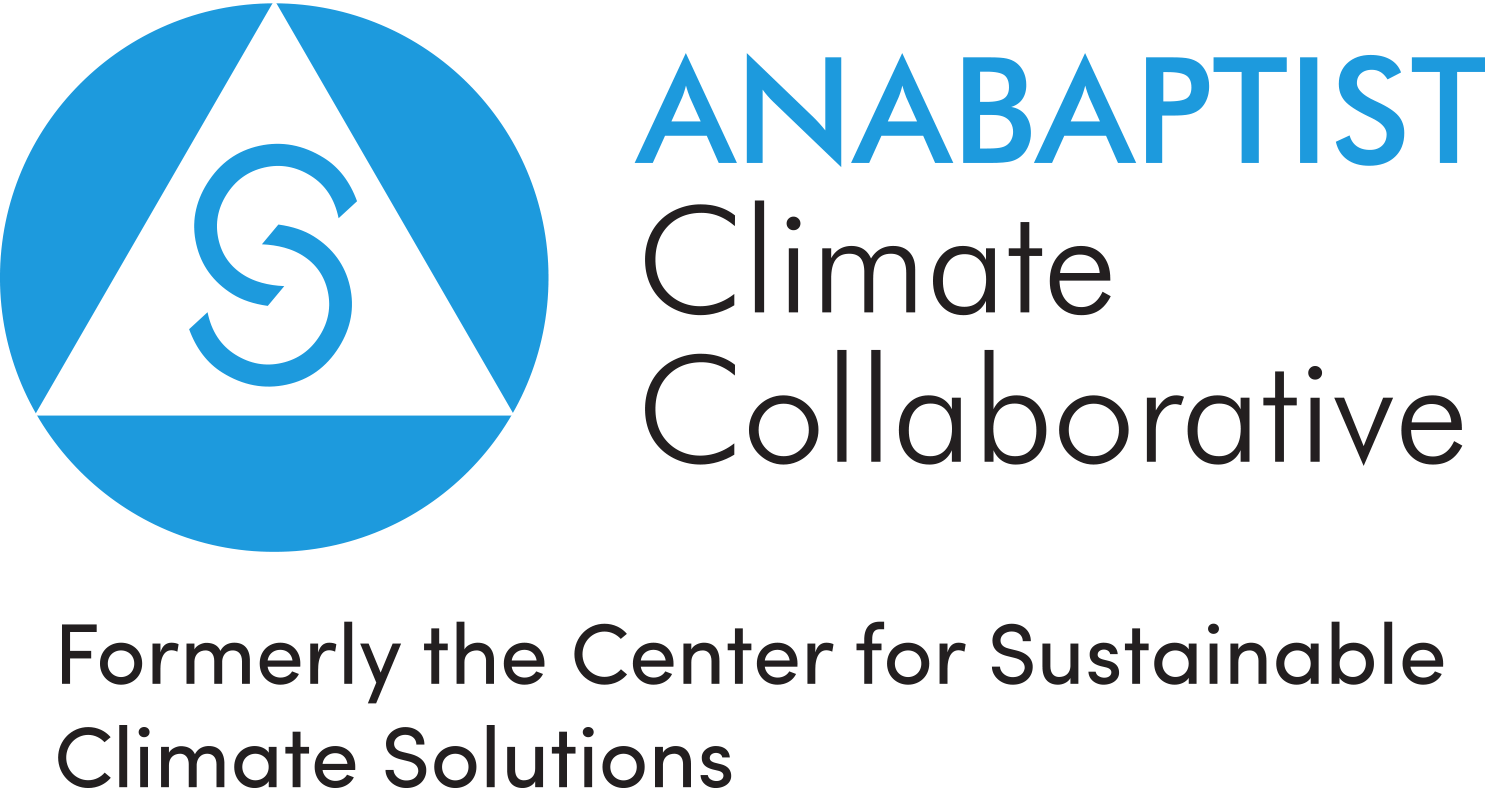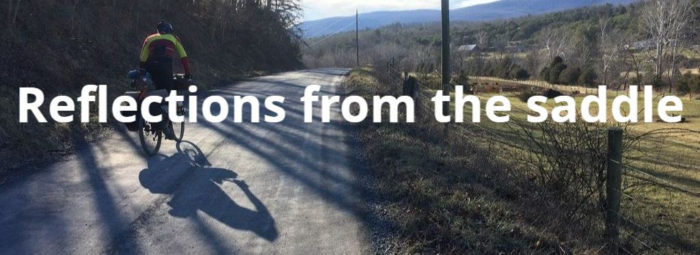
By Liz Miller
Hesston College chapel
Hesston, KS, October 15
There’s lots of gear that goes into a cycling trip, and I’m guessing that many of you, as I was a few months ago, are unfamiliar with some of it. So, I’ll cover some of the essentials:
Gatorade Powder
It was Day 3, in eastern Washington, and it was hot that day. It was so hot that we couldn’t ever get quite enough liquids. Water was hard to drink, and food didn’t go down well, and the iced gatorade we made at the last rest stop went hot in our bottles. Not pleasant at all, but electrolytes.
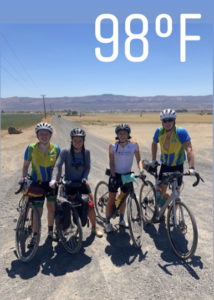
We went about 70 miles that day. In the afternoon, as we passed miles and miles of fruit trees, I remember thinking, so that’s where my apples come from.
For those last several miles, every sign we passed was in Spanish. Some advertised work. One of them read, “Hugo’s Tacos” and was advertising a mouth-watering snack that I knew would make me feel sick if I stopped. So we kept going. Then we passed a dormitory, complete with campo de futbol, a soccer field, that had a sign, in Spanish, that said “no guests allowed.”
With a clear Spanish speaking population, my mind began to turn to immigration issues. I started wondering about their lives. How did they get there? What were the challenges they faced? According to the USDA, approximately 50 percent of farm workers in Washington State may be undocumented.
Friends, so much of what we know and consume comes from the labour and hands of those who are treated as “other.” Who are necessary to the economy but never quite welcomed.
What would happen if we started thinking about whose bodies, souls, and humanity are behind the things we buy, and the way that those people are being treated?
Front Pouch
Missoula, Montana was where I bought my front pouch, since I had realized during that first exhausting week of riding that I didn’t quite have enough storage on my bike for all the snacks I needed to eat, plus so many warm layers of clothing that had to be stripped after crisp mountain mornings.
It was Day 8 when we rode into Missoula, Montana– finally, riding into our rest day, and this is what our view looked like. But what should have been a celebration at the completion of our first exhausting week of riding was a disappointment for me. We were grouped based on pace that day, and I was put in the slowest group. I had been working so hard to prove myself, and I felt devastated that “slow” was how they viewed me. Not as strong and capable as the rest. A blow to my ego and my belief in my own athleticism.
So, I spent that day with a bad attitude, hanging ahead of the rest of the group, trying to prove that I could go faster. When we finally got into camp, it was just in time for dinner. Everyone was already showered and so cheerful, talking about how much fun they had had swimming in the pool that afternoon. I had missed out and couldn’t let it go.
A few days later, we got to pick our own groups. I was nervous, thinking no one was going to pick me, and another friend voiced similar concerns. We created our own group, and included those who I had ridden with a few days before. This time, I was convinced not to have a bad attitude. It was a shorter day, and we decided we were going to have as much fun as possible.
That evening, our group came together for a conversation, at this campsite: people had voiced dissatisfaction with the ways we had been riding in groups up to that point. We liked riding at our own paces and didn’t enjoy waiting around for others who were slower than them. We all competed with each other to see who could get in to camp the fastest, as if being “first” were still a measure of greater success when we were all accomplishing so much just by completing such long rides (60-80+ miles per day) every single day.
I had been thinking about this a lot within myself: I also liked to go my own pace, but after that day riding into Missoula, I realized that focusing so much on speed and competition was tearing us apart. If we wanted to work at this as a team, encourage each other through it all, and make it across the country together, we had to let that go.
And it was also about climate justice for me– hear me out. When we think about climate change, we know that environmental degradation has happened because of so much resource extraction (you’ve seen it– deforestation and conflicts over oil are examples of this).
Why would we purposely take away the earth’s goodness- it’s beauty as well as its ability to regulate itself? Why would we purposely cause violence to other people? Because taking those resources from the earth in mass amounts and selling them brings profits in mass amounts. That’s the idea of the economic system of capitalism: it’s focused on growth– to make the most amount of money, no matter the cost to the earth or other people.
But– I realized I was doing the same thing in my own body on this trip. I was trying to keep up, to get to the destination as fast as I could, to extract as much from my body as possible in order to gain more respect from myself and my teammates for my athletic ability. In the process, I was missing what was in between where we started and where we ended each day.
If I couldn’t stop the pattern of that extractive capitalism within my own body, how could I possibly say I was working to end that cycle in much greater social systems and in advocacy of the earth? How could we as a team say we were riding for climate justice if we didn’t think about the same embodied systems that dictated our relationships with ourselves and our teammates?
Derailleur Hanger
Who knew that a derailleur hanger was a thing? I didn’t. Not until Wyoming, when we were riding through Yellowstone National Park (which, by the way, was a day of 5,000 feet of elevation gain over 70 miles). Going up all those hills, my shifting was crunchy, and sometimes my feet would come unclipped from their pedals and I felt like I might crash right in the middle of all that traffic on those narrow park roads.
My crunchy shifting? That was caused by the little tiny derailleur hanger that was bent, no bigger than the size of my thumb but causing me all sorts of grief. I rode through all of Wyoming — and most of the Midwest– on that bent derailleur hanger, and started getting the hang of it: through the rest of Yellowstone, up and down the Bighorn mountains, which are part of the Rockies, and through this little tiny town, population 2, called Spotted Horse, where we stopped at a bar– our only water source for miles.
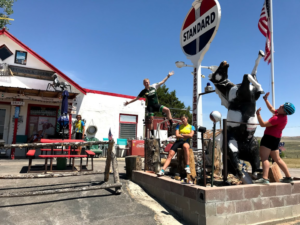
We went in to fill up our bottles, as always, wherever we could get water. Sometimes we would fill up in bathroom sinks, or at spigots outside the building. This time we bought cheese fries and asked the woman at the bar if she could fill them for us.
“The tap water in this town isn’t safe to drink,” she told us. “I can sell you bottles, though.” Our group collectively bought her out of bottled water that day.
That got me thinking about the year that I spent in Honduras, 2018-2019, living with a host family not far outside of the capital city of Tegucigalpa. The water source in that particular community had run dry a few years back, and water had to be shipped in on trucks. One week, they delivered brown water for the entire week. Some of my neighbors only used styrofoam all week because they didn’t have access to clean water to wash their dishes. There was a common phrase at the school where I worked and around the city: el agua es vida. Water is life.
Riding through Spotted Horse that day, unable to drink the water from the tap even though we needed hydration terribly, reminded me again that el agua es vida. Water truly is life. Some people have greater access to that life source, and others have less access. What are we doing to protect the quality of our bodies of water? What are we doing to conserve our precious life-giving resources?
Windbreaker
We’d had a stretch of pretty long days, and the particular day we rode into Devils Tower National Monument, Wyoming was advertised to us by our leader as an “easy” day. Just 62 miles! As it turns out, it was the easy day that made me cry. 62 miles into a headwind is anything but “easy.” I rode into camp ready to tap out– but instead, it was an afternoon of leaning in and spontaneous learning.
As we were pulling up to camp, we saw that we had teepees on our campsite– and not only that, but they were being set up just for us.
We arrived right around the summer solstice, the day after an indigenous ceremony at the sacred site to celebrate the solstice. The teepees needed to be set up to dry out, so we curious humans were gifted with a shelter to sleep in for the night. This was all thanks to our lovely support couple, Dan and Mary Ann, who went ahead of us with the truck and trailer. They were always quick to start up conversations with the local people we met along the way, which often provided our whole group with spontaneous learning opportunities. Having spent a good portion of their lives on Navajo Nation in New Mexico, they were especially curious to learn from the Northern Cheyenne, Lakota, and other indigenous groups that were there for the solstice ceremony.
The two Northern Cheyenne brothers who set the teepees up for us were named Thaddeus and Cleroy. Cleroy was quiet, but Thaddeus talked to us all afternoon, our whole group huddled together, warm inside one of the teepees while the wind howled around us. He told us many stories that are only his to tell, but one important piece of information is that Devils Tower is known as Bear Lodge among indigenous communities. The name didn’t change until the early 20th century, after a military expedition.
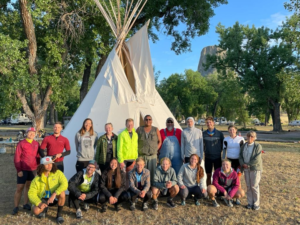
It was a faulty translation of language during the colonizers’ journey that changed the sacred landmark’s identity from that point forward.
Even something as simple as who gets to decide a name, and which name sticks, reveals power dynamics and the ripples of oppression. The words we choose matter– not just choosing kind words, but choosing words that honor people’s dignity, choosing words that speak out against oppression.
Cycling Cap
As we made our way out of the West and entered the Midwest, the early July wildflowers painted themselves along the roadside in vibrant yellows, purples, whites, and oranges. But with the beauty came the humidity that we’ve all come to know.
We were in Iowa, riding into another rest day, mostly on gravel. Iowa gravel is special. You know how Kansas gravel is small and sandy? Iowa gravel is just chunky– and chunky gravel on Iowa hills… well, let’s just say it takes a special kind of determination. Determination which, heading into rest day, I was a little low on. And the sweat was just rolling down my face: down my forehead, into my eyeballs, out my eyeballs, and down my cheeks. By the end of the day, I couldn’t tell which tears were sweat and which tears were frustration.
That was the day I learned the purpose of a cycling cap, this hat that I’m wearing now. It wicks the sweat into the bill and keeps it from streaming down your face. And when it’s raining, it helps keep the rain off your face, too. It turned out to be a lifesaver as we crossed the Midwest and the East.
We took our rest day at the Geyer Farm about 15 miles outside of Iowa City, a farm that is in the process of switching over from conventional agriculture practices (row crops like corn and soybeans) to growing table food. They’ve tried methods like no-till, cover crops, and organic production, and this year was the first season that their neighbor planted kidney beans on their land.
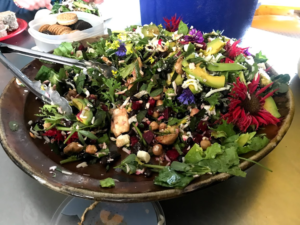
Anna Geyer also showed us her food forest, a garden that had all sorts of different plants growing up together: clover covering the soil, black currants, garlic, kale, squash, fruit trees, flowers, and so much more. The idea was that the ecosystem thrives and is able to self-regulate when all components of a forest are present– like understory, vines, subcanopy, and canopy layers.
Our whole way through the Midwest there was a focus on agriculture. In Iowa City, we got to tour pollinator gardens for Monarch butterflies. After an especially rainy week, we stayed at Hungry World Farm in Tiskilwa, Illinois. In Goshen, Indiana, we toured Clay Bottom Farm. Not far from there, we toured Goshen College’s Merry Lea Environmental Learning Center. All of them had different approaches to what sustainability meant to them, but all of them were justice-minded.
Seeing all those farms doing amazing things made me think about my own family’s farm in Northwest Ohio. I spent a lot of time dreaming about what sustainable growing methods I could try on the land that my family is on. Would I try a food forest, like at the Geyer farm? Or perhaps restore a portion of the farm to its original wetland state, like at Merry Lea?
And were implementing mere sustainable models on the farm enough? I thought a lot about how important it is to follow the leadership of BIPOC growers when thinking about sustainable agriculture. Would I pay real rent to the indigenous communities in my region? Would I participate in the LandBack campaign and return the land to indigenous ownership?
These questions followed me through the final days of the trip.
Purple Handlebars & Ducky
On the hilliest day of the trip, riding into Pittsburgh, Pennsylvania, my shifting broke with 35 miles to go. Thankfully, we had made it past the toughest climbs earlier that morning. I stopped at a bike shop in the city, where they miraculously had exactly the shifter I needed for the last 5 days. They installed the shifter, and let me pick out new handlebar wrap. Naturally, I chose purple.
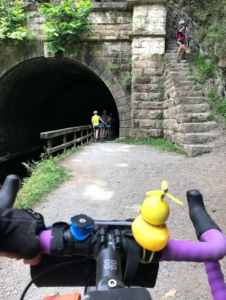
The ducky on my handlebars I’d say is representative of friendship and joy. My coach Joanna gifted it to me in Washington, DC, after letting me borrow it for that last week of riding. The last week was filled with so much laughter , spontaneous swims , tree climbs, and so many coffee stops. Never too much. By the end of the trip, I think I’d learned something about freeing my body from the capitalist system I talked about earlier. No longer were we worried about pace, but instead, we rode with friends and embraced the touring lifestyle. We got in late to camp on purpose, just because we stopped so many times to enjoy ourselves along the way.
Riding into Washington, DC was the biggest accomplishment I think I’ve ever felt in my life. We dipped our tires into the reflection pool of the Washington Monument to commemorate the end of the trip, just as we had done at the beginning in the Elliot Bay in Seattle, Washington.
But we had one final task: to meet with our elected officials. Here you’ll see the Ohio group– myself, Issac, and Denver– waiting on Zoom for our first meeting. We had three meetings in total, meeting with the staffers of our Representatives and Senator. In those meetings, we told our stories of the summer and made specific asks for climate legislation.
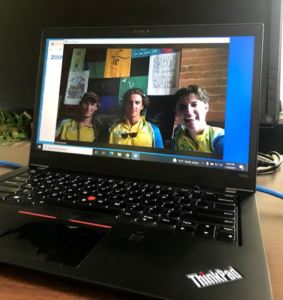
But as I learned over the summer, it’s important to advocate for so much more than just climate legislation. Climate justice includes all sorts of other social justice work: because the well-being of humans and the earth goes hand in hand.
I saw how human and environmental well-being goes hand and hand in my observations around immigration, in my relationship with my own body, in the need for clean water sources, in the way indigenous nations honor the land and seasons, and in all the different models of sustainable agriculture that I learned about.
And after an entire summer dedicated to riding and learning, I can’t be silent about things that are important.
Friends, I believe that none of us should be silent about things that are important– or else we’re just contributing to violence. I know that most of you aren’t cyclists, but there’s still so much you can do for climate justice, even if you don’t know much about environmental issues.
It’s young people like us who can make a difference. Maybe we don’t have it all figured out yet, but when we truly believe that we can make the world a better place, we do. I’ve been telling you about some of the stories that inspire me to make the world a better place. But what is it for you, friends? How will you use your own stories to create positive change on this campus and in this world?
